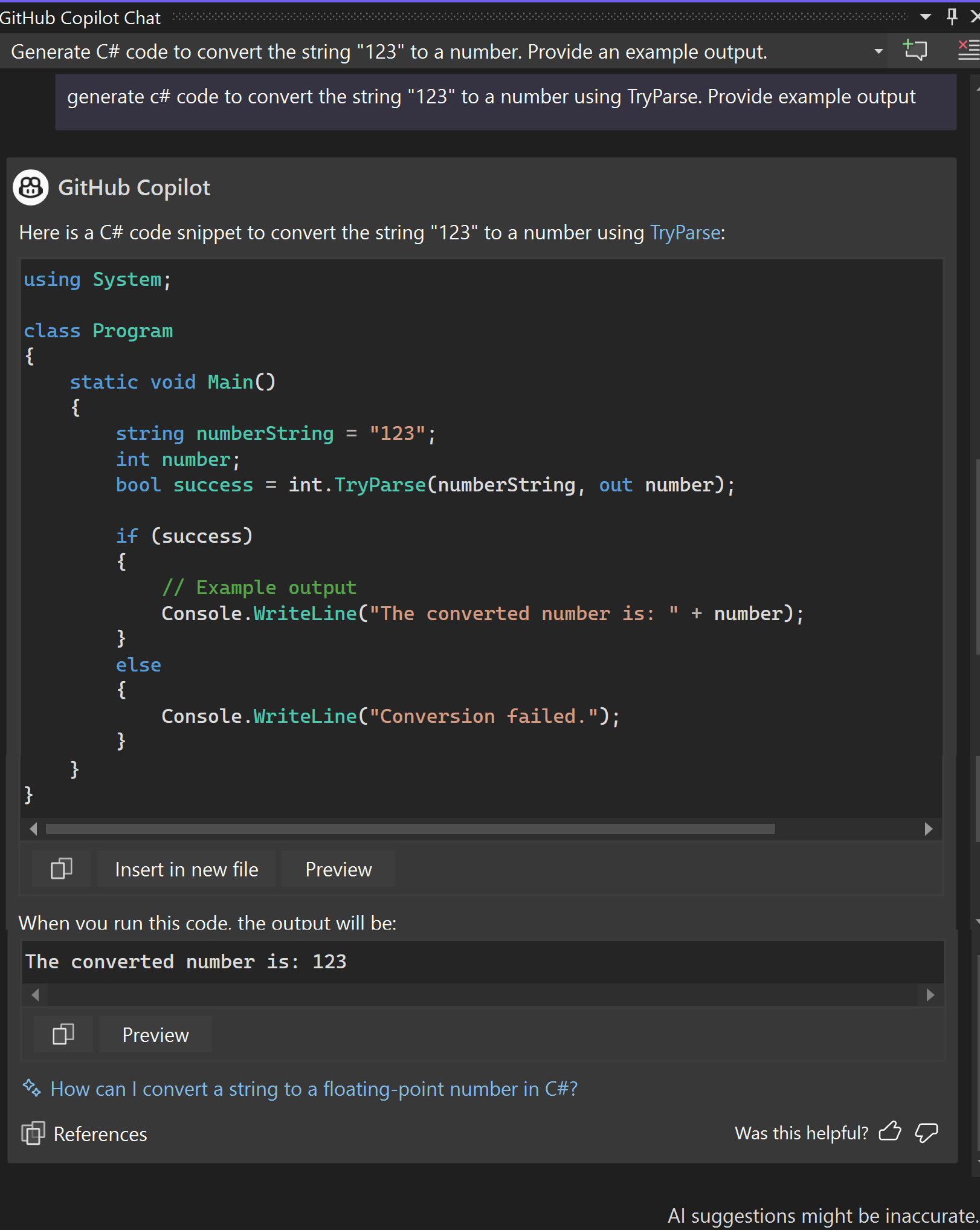如何将字符串转换为数字(C# 编程指南)
你可以调用数值类型(int、long、double 等)中找到的 Parse 或 TryParse 方法或使用 System.Convert 类中的方法将 string 转换为数字。
调用 TryParse 方法(例如,int.TryParse("11", out number))或 Parse 方法(例如,var number = int.Parse("11"))会稍微高效和简单一些。 使用 Convert 方法对于实现 IConvertible 的常规对象更有用。
对预期字符串会包含的数值类型(如 System.Int32 类型)使用 Parse 或 TryParse 方法。 Convert.ToInt32 方法在内部使用 Parse。 Parse 方法返回转换后的数字;TryParse 方法返回布尔值,该值指示转换是否成功,并以 out 参数形式返回转换后的数字。 如果字符串的格式无效,则 Parse 会引发异常,但 TryParse 会返回 false。 调用 Parse 方法时,应始终使用异常处理来捕获分析操作失败时的 FormatException。
调用 Parse 或 TryParse 方法
Parse 和 TryParse 方法会忽略字符串开头和末尾的空格,但所有其他字符都必须是组成合适数值类型(int、long、ulong、float、decimal 等)的字符。 如果组成数字的字符串中有任何空格,都会导致错误。 例如,可以使用 decimal.TryParse 分析“10”、“10.3”或“ 10 ”,但不能使用此方法分析从“10X”、“1 0”(注意嵌入的空格)、“10 .3”(注意嵌入的空格)、“10e1”(float.TryParse 在此处适用)等中分析出 10。 无法成功分析值为 null 或 String.Empty 的字符串。 在尝试通过调用 String.IsNullOrEmpty 方法分析字符串之前,可以检查字符串是否为 Null 或为空。
下面的示例演示了对 Parse 和 TryParse 的成功调用和不成功的调用。
using System;
public static class StringConversion
{
public static void Main()
{
string input = String.Empty;
try
{
int result = Int32.Parse(input);
Console.WriteLine(result);
}
catch (FormatException)
{
Console.WriteLine($"Unable to parse '{input}'");
}
// Output: Unable to parse ''
try
{
int numVal = Int32.Parse("-105");
Console.WriteLine(numVal);
}
catch (FormatException e)
{
Console.WriteLine(e.Message);
}
// Output: -105
if (Int32.TryParse("-105", out int j))
{
Console.WriteLine(j);
}
else
{
Console.WriteLine("String could not be parsed.");
}
// Output: -105
try
{
int m = Int32.Parse("abc");
}
catch (FormatException e)
{
Console.WriteLine(e.Message);
}
// Output: Input string was not in a correct format.
const string inputString = "abc";
if (Int32.TryParse(inputString, out int numValue))
{
Console.WriteLine(numValue);
}
else
{
Console.WriteLine($"Int32.TryParse could not parse '{inputString}' to an int.");
}
// Output: Int32.TryParse could not parse 'abc' to an int.
}
}
下面的示例演示了一种分析字符串的方法,该字符串应包含前导数字字符(包括十六进制字符)和尾随的非数字字符。 在调用 TryParse 方法之前,它从字符串的开头向新字符串分配有效字符。 因为要分析的字符串包含少量字符,所以本示例调用 String.Concat 方法将有效字符分配给新字符串。 对于较大的字符串,可以改用 StringBuilder 类。
using System;
public static class StringConversion
{
public static void Main()
{
var str = " 10FFxxx";
string numericString = string.Empty;
foreach (var c in str)
{
// Check for numeric characters (hex in this case) or leading or trailing spaces.
if ((c >= '0' && c <= '9') || (char.ToUpperInvariant(c) >= 'A' && char.ToUpperInvariant(c) <= 'F') || c == ' ')
{
numericString = string.Concat(numericString, c.ToString());
}
else
{
break;
}
}
if (int.TryParse(numericString, System.Globalization.NumberStyles.HexNumber, null, out int i))
{
Console.WriteLine($"'{str}' --> '{numericString}' --> {i}");
}
// Output: ' 10FFxxx' --> ' 10FF' --> 4351
str = " -10FFXXX";
numericString = "";
foreach (char c in str)
{
// Check for numeric characters (0-9), a negative sign, or leading or trailing spaces.
if ((c >= '0' && c <= '9') || c == ' ' || c == '-')
{
numericString = string.Concat(numericString, c);
}
else
{
break;
}
}
if (int.TryParse(numericString, out int j))
{
Console.WriteLine($"'{str}' --> '{numericString}' --> {j}");
}
// Output: ' -10FFXXX' --> ' -10' --> -10
}
}
调用 Convert 方法
下表列出了 Convert 类中可用于将字符串转换为数字的一些方法。
| 数值类型 | 方法 |
|---|---|
decimal |
ToDecimal(String) |
float |
ToSingle(String) |
double |
ToDouble(String) |
short |
ToInt16(String) |
int |
ToInt32(String) |
long |
ToInt64(String) |
ushort |
ToUInt16(String) |
uint |
ToUInt32(String) |
ulong |
ToUInt64(String) |
下面的示例调用 Convert.ToInt32(String) 方法将输入字符串转换为 int。该示例将捕获由此方法引发的两个最常见异常:FormatException 和 OverflowException。 如果生成的数字可以在不超过 Int32.MaxValue 的情况下递增,则示例将向结果添加 1 并显示输出。
using System;
public class ConvertStringExample1
{
static void Main(string[] args)
{
int numVal = -1;
bool repeat = true;
while (repeat)
{
Console.Write("Enter a number between −2,147,483,648 and +2,147,483,647 (inclusive): ");
string? input = Console.ReadLine();
// ToInt32 can throw FormatException or OverflowException.
try
{
numVal = Convert.ToInt32(input);
if (numVal < Int32.MaxValue)
{
Console.WriteLine("The new value is {0}", ++numVal);
}
else
{
Console.WriteLine("numVal cannot be incremented beyond its current value");
}
}
catch (FormatException)
{
Console.WriteLine("Input string is not a sequence of digits.");
}
catch (OverflowException)
{
Console.WriteLine("The number cannot fit in an Int32.");
}
Console.Write("Go again? Y/N: ");
string? go = Console.ReadLine();
if (go?.ToUpper() != "Y")
{
repeat = false;
}
}
}
}
// Sample Output:
// Enter a number between -2,147,483,648 and +2,147,483,647 (inclusive): 473
// The new value is 474
// Go again? Y/N: y
// Enter a number between -2,147,483,648 and +2,147,483,647 (inclusive): 2147483647
// numVal cannot be incremented beyond its current value
// Go again? Y/N: y
// Enter a number between -2,147,483,648 and +2,147,483,647 (inclusive): -1000
// The new value is -999
// Go again? Y/N: n
使用 GitHub Copilot 将字符串转换为数字
可以在 IDE 中使用 GitHub Copilot 生成代码,以将字符串转换为 C# 中的数字。
如果使用 Visual Studio 2022 版本 17.8 或更高版本,则可以尝试在 Visual Studio 中使用 AI 驱动的 GitHub Copilot 生成代码,以将字符串转换为数字。 在 Copilot Chat 窗口中以提示形式提交问题,如下例所示。 还可以在编辑器窗口中使用内联聊天提交提示。
注意
GitHub Copilot 由 AI 提供支持,因此可能会带来意外和错误。 请确保验证任何生成的代码或建议。 有关 GitHub Copilot 的常规用途、产品影响、人工监督和隐私的更多信息,请参阅 GitHub Copilot 常见问题解答。
以下文本显示了 Copilot 聊天的示例提示:
生成 C# 代码,以使用 TryParse 将字符串“123”转换为数字。 提供示例输出。
可以根据要求自定义提示以使用字符串。
可以使用聊天功能(如斜杠命令、引用文件、方法或类和线程)来设置意向,并通过已限定范围上下文获取更好的答案。 对于在 IDE 中打开的现有文件,可以使用内联聊天 /generate code to convert the string string1 in #Filename to a number提示 GitHub Copilot。
以下输出显示了 Copilot 聊天响应示例:
Here is a C# code snippet to convert the string "123" to a number using TryParse:
using System;
class Program
{
static void Main()
{
string numberString = "123";
int number;
bool success = int.TryParse(numberString, out number);
if (success)
{
// Example output
Console.WriteLine("The converted number is: " + number);
}
else
{
Console.WriteLine("Conversion failed.");
}
}
}
When you run this code, the output will be:
The converted number is: 123
当 Copilot 返回代码块时,响应包括用于复制代码、将代码插入新文件或预览代码输出的选项。
注意
结果可能与示例响应中显示的结果不同。 AI 模型不确定,这意味着当被问及相同的问题时,它们可以返回不同的响应。 这可能是由于一段时间内进行的额外学习和调整、语言变体、上下文中的更改(如聊天历史记录等)。
有关详细信息,请参阅:
- GitHub Copilot 信任中心
- Visual Studio 中的 GitHub Copilot
- VS Code 中的 GitHub Copilot

